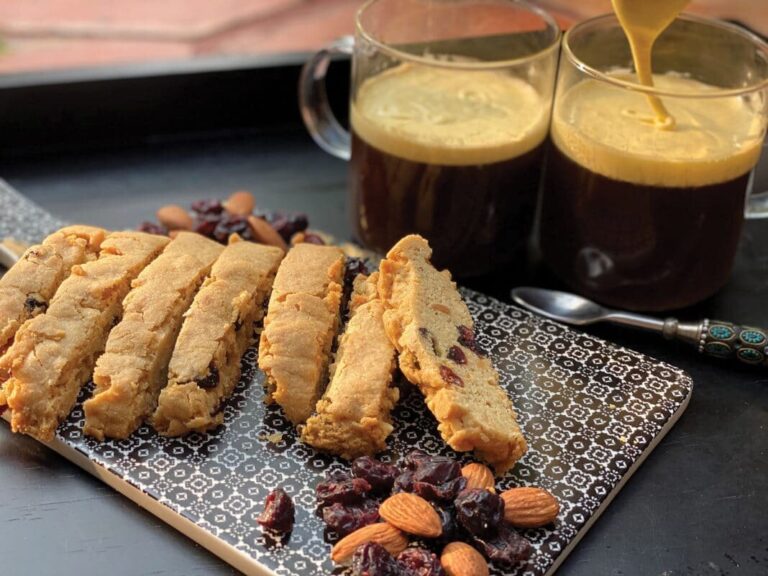Blessings and Burmuelos: A Matzah Fritter Recipe
The burmuelos are served with lots of sour cream, honey and fruit jam, fresh berries and melon.

Every year, before Passover, Rachel and I sit and discuss what recipes we will be making for the Jewish Journal. Every year, I drive Rachel crazy and I tell her that we have to make our recipes non-gebrokts, meaning that they can’t have matzo meal or cake meal in them.
Of course, the paradox of Passover is that the central thing that we are avoiding, “chametz,” or wheat, is also the main ingredient in the symbolic food that we eat, matzah. Sephardim, in general, are a little less stressed about Passover than Ashkenazim. You know, the whole kitniyot (legumes) thing. And we definitely aren’t as concerned about getting our matzah wet.
As a very little girl, I remember my grandmother running the tap water over the matzah before she would make me a sandwich with her special Passover frittatas (small omelets made with sautéed onion, chopped Italian parsley and tomato).
As you might imagine, gebrokts is a Yiddish word for foods that include matzah meal as an ingredient, like matzah ball soup. I know about gebrokts because my brother Rafi is a faithful Hasid of the Lubavitcher Rebbe. Chabad is extra strict on Passover. They eat their shmura matzah (matzah that’s been guarded to prevent it from leavening) very carefully, making sure that it never comes into contact with any liquid. Only fruits and vegetables that can be peeled are consumed. No grapes or strawberries! In general, the only prepackaged food items my brother and sister-in-law use are extra virgin olive oil, Schmerling chocolate from Switzerland and pure honey.
One of my favorite Passover memories is when my brother Rafi joined us with his young children, Devorah and Yosef. He set up his own kitchen with a hot plate and a blender. He bought huge boxes of fresh produce and had the kids on a diet of hard-boiled eggs, avocados, mashed potatoes, roast meat and fruit and banana smoothies.
After Shabbat lunch, a still hungry three-year-old Yosef surreptitiously stuck his fingers in the leftover T’bit (Iraqi chicken and rice hamin) and gobbled as much rice as he could. My father stood there, watching him and laughing with great amusement. At another meal, we were eating shepherd’s pie. Eight-year-old Devorah, faced with her father’s less delicious food, wailed “I just want to eat what they’re eating!”
I write this article from the airport in Jamaica, where we just celebrated the wedding of Devorah and Daniel. The bride was beautiful and radiant, the groom was handsome. The food was delicious — lots of fresh fruit and peppery jerk chicken. The scenery was spectacular — lush green jungle and turquoise blue surf. The energy was joyful and exuberant.
May Hashem bless them with many years of health and happiness and many, many delicious meals.
—Sharon
Sharon was busy traveling to Montego Bay, so this year I get to share my family’s favorite Passover food, burmuelos.
Popular throughout the Eastern Mediterranean, the recipe for burmuelos traveled to the tiny, close knit Ladino community on the island of Rhodes.
You might be familiar with burmuelos from Hanukkah, a fluffy, flour and yeast deep fried doughnut. But on Passover, they are matzah fritters made with crushed matzah or farfel that has been soaked in water and mixed with beaten eggs, feta and grated parmesan cheese. After the expulsion from Spain and Portugal, the Sephardim brought the recipe with them to Istanbul and the other cities of Turkey. Popular throughout the Eastern Mediterranean, the recipe for burmuelos traveled to the tiny, close knit Ladino community on the island of Rhodes.
Our favorite family Passover traditions are the lunches when Neil fries up burmuelos after returning from synagogue.
First, Neil soaks the matza farfel, then he whisks eggs with feta and grated Parmesan cheese and then he combines the farfel and egg mixture.
He drops big spoonfuls of the mixture into piping hot oil. The result is a crispy, crunchy exterior with a fluffy, salty, cheesy interior.
The burmuelos are served with lots of sour cream, honey and fruit jam, fresh berries and melon. There might be huevos haminados (cooked brown eggs) overnight and perhaps a spinach cuajado (a crustless vegetable quiche) and crispy leek patties leftover from the Seder.
We like to triple the recipe because the leftovers are just as delectable. We eat the leftovers for breakfast or as snacks. Burmuelos can be perfectly reheated in the oven.
—Rachel
Burmuelo Recipe
2 cups matzah farfel (or crushed matzah)
2 large eggs, at room temperature
1/2 tsp salt
1/2 cup grated Parmesan (optional)
1/2 cup crumbled feta
Pepper to taste
Vegetable oil, for frying
Soak matzah farfel in 1 cup warm water. After two minutes, squeeze out the water.
In a large bowl, whisk the eggs and salt.
Add the two cheeses and the farfel and mix well to combine.
Warm oil in a large skillet over medium high heat. When the oil is very hot, use a large spoon to drop several spoonfuls into the pan. Fry until golden, then flip and fry the other side.
Serve with sour cream and honey.
Labneh and fruit preserves are also delicious with burmuelos.
Sharon Gomperts and Rachel Emquies Sheff have been friends since high school. The Sephardic Spice Girls project has grown from their collaboration on events for the Sephardic Educational Center in Jerusalem. Follow them on Instagram @sephardicspicegirls and on Facebook at Sephardic Spice SEC Food.







